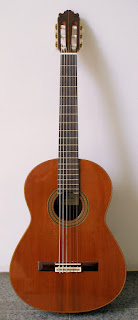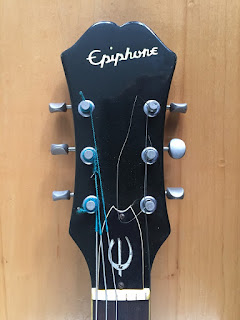This marks the growing popularity of this important builder.
There are 28 instruments known in existence all over the world.
13 instruments were to be seen at the event. I was invited but
I had a performance. Organized by Stefano Grondona.
a double back. I bought this one on a flea market in Belgium
being not fully aware of it's value and tonal qualities.
Arias was the only luthier in the 19th century whose work
came close to rivalling that of Antonio deTorres.
I would like to ask your attention for the Orfeo magazine
and the publisher / Photographer Alberto Martinez. He
wrote a book about this remarkable luthier and his
photograph work simply is gorgeous. The two pictures
here above are from his hand.
 This was the last label used by the later Madrid based luthier.
This was the last label used by the later Madrid based luthier.This guitar dates from the year 1899, the same year the instrument
of Raphaëlla Smit has been built. The resemblance of the
tonal color of the different Arias guitars is remarkable
in spite of his experiments.
 Vicente Arias was really praised for his beautiful rosettes:
Vicente Arias was really praised for his beautiful rosettes:They all are different and this particular instrument has a
beautiful decorated lining as well.

Though it's not the back of the 1899 guitar it can be
clearly seen that the typical darkcoloured Rio Palissander
was used being so common in the 19th century.
The tuners are a replacements.
Arias often equipped his guitars with violinlike
tuning pegs because of the lightness of his guitars.
Luckily I found another picture. The back from the 1899
Vicente Arias guitar. As this guitar has adouble back the
inner back can only be seen around the label. It was out
of one piece of Brasilian rosewood.













































